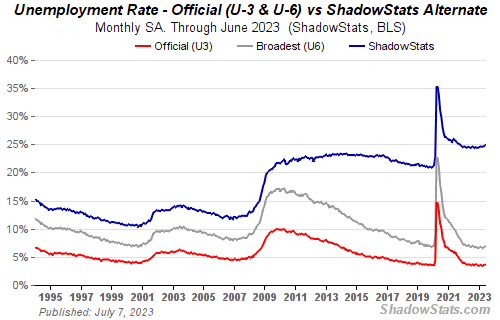
Back in the early 1980's, Alan Greenspan, the former Chairman of the Federal Reserve Bank, came up with a great idea. He reasoned that if the price of one commodity goes up, consumers will switch to another commodity in its place. On the basis of this reasoning, the method of calculating the Consumer Price Index was changed. The result is that the inflation rate reported by the US Government is reported to be lower than it would if it was still calculated the old way.
John Williams, the economist who operates "Shadow Government Statistics" likes to publish economic statistics as they would be if the CPI methodology hadn't been changed. This chart is a comparison of growth in the "real" (adjusted for inflation) US Gross Domestic Product using both the current CPI and the old methodology. When the line is above zero the economy is growing, with higher levels being greater levels of growth. When the line is below zero, the economy is shrinking, and in a recession. The lower the line goes, the more severe the recession.
The chart speaks for itself. The recession is deeper and has been around longer than the government tells us.
 The GDP isn't the only place John believes the government is cooking the books. This second chart is of the unemployment rate, with the "discouraged" workers added back into the numbers. According to Williams, these workers were "defined out of existence in 1994."
The GDP isn't the only place John believes the government is cooking the books. This second chart is of the unemployment rate, with the "discouraged" workers added back into the numbers. According to Williams, these workers were "defined out of existence in 1994."Lets see, 22% unemployment and GDP contracting at a 6% annualized rate and has been for the last decade except for a tiny spurt of growth in 2004.
Yep, Keynesian economics is workin' jus' fine. 'Specially with those nice men from the government here to help us.
Comments